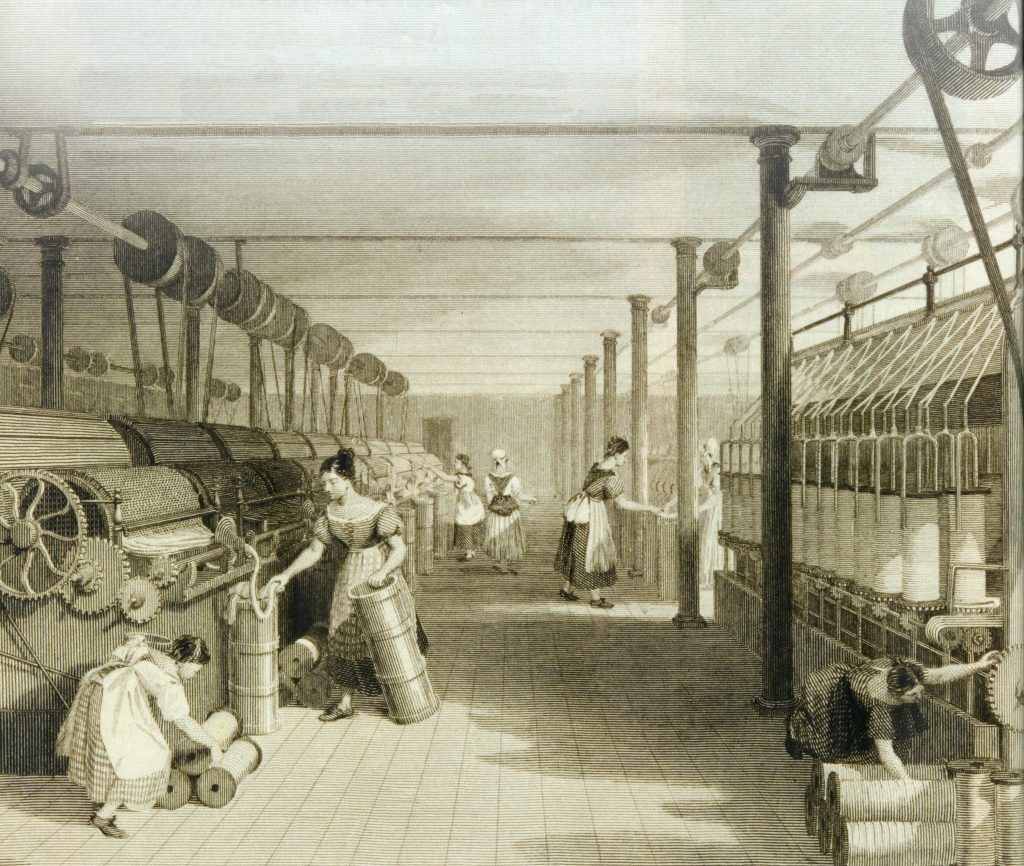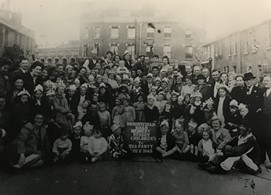Children today spend five days a week going to school for eight hours. During the first half of the nineteenth century in Britain, this was not the case. Instead, children even as young as five or six would toil all day long in factories or in mines. They had no breaks, no time off, and no schooling. Their work often led to horrible accidents, children being injured for life, and children left without an education.
Children laboring, of course, did not start with the British Industrial Revolution. It had been a normal part of life in Europe since the middle ages, when children helped their parents on farms and with household work. The people’s perception of this work, however, changed during the Industrial Revolution, since that is when people began to see this new kind of labor, factory labor, as an injustice and even criminal.1
The Industrial Revolution began in Britain during the 1780’s and rapidly changed the work process and the social relations of work. Prior to the Industrial Revolution, most people worked directly in the production of food, usually as farmers on their own farms. When textile factories began forming in the new factory cities, instead of working on their farms and making what their family needed, people left their farms and moved into the factory cities to make a living. Factory conditions of work, however, were far different from the work rhythms of farm life. In fact, they were brutal in comparison. Factory workers would typically put in between 12 and 16 hour days, working for meager wages. The machines they attended were dangerous, and the workers were often on their feet throughout the day, with perhaps a half-hour break for meals. Among these workers were children, many of whom were as young as five or six years old. Children were valued as workers for their small stature and ability to climb into small places and do things that adults often could not do. This often resulted in mutilation and the loss of appendages for many of these children.2
Children were also valued as workers by the factory owners because of the low wages that they were paid. Men were paid the most in factories, followed by women and then children. These wages, however small, were needed by the families of these children simply to survive. The parents often sent their children out to work to help pay for rent, food, and otherwise help make ends meet.3
One reason that the British public became outraged by child labor practices was the fact that children in factories were not receiving an education. Horace Mann, an American educational reformer, stated:
No greater calamity can befall us as a nation than that our children should grow up without knowledge and cultivation. If we do not prepare them to become good citizens, develop their capacities, enrich their minds with knowledge, imbue their hearts with a love of truth and all things holy, then our republic must go down to destruction as others have gone before it.4
This represents the thoughts of the British at the time, which was being echoed in the United States during its own industrial revolution. People wanted to ensure the future of their nation, which starts with the young. They believed that children should attend school for at least a while.5 This led to several laws being passed to raise the legal age of work.
In 1833, the British Parliament passed the Regulation of Child Labor law to help improve the working conditions for children in factories. The Law limited the age of workers, saying that they had to be older than nine with an age certificate to prove it, and that children 9-13 could not work for more than nine hours a day. Additionally, children 13-18 were not permitted to work longer than twelve hours a day. Along with these work-hour restrictions, the law also made school attendance a two-hour requirement, and said that children could not work at night. Fines for breaking these rules were small, however, so they were frequently violated, often with impunity.6

Many other pieces of legislation were also passed to place limits on the gender, hours, and ages of workers. The Mining Act of 1842 prevented women and girls from working in mines, and the Ten Hours Bill of 1847 set ten as the maximum number of daily working hours for women and children. This act was hated by factory owners because they believed it would hurt the textile industry’s competitiveness worldwide. After these bills, others followed to ensure their effectiveness, and to ensure that they would be properly implemented.7
By 1900, the minimum working age had been raised to twelve years of age and child labor had decreased drastically in Great Britain. However, the introduction of legislation against child labor provoked its share of protests as well. Because of these protests, Parliament established commissions to collect evidence of abusive practices. These were called the Blue Books or Sadler Reports. They interviewed children, parents, factory workers, owners, and even doctors on the condition of children in textile factories. Unsurprisingly, the reports uncovered a range of serious abuses by factory owners and overseers. Unfortunately, most critics just said that the claims were exaggerated in order to continue their money making practices.8
The legislation surrounding the British Industrial Revolution had become very effective by 1900, and child labor and its accompanying abuses had decreased dramatically. By 1900, most children were attending school instead of working in factories. The laws passed finally added up to changing British child labor to being closer to what we see today, a mostly child-free labor system, with children going to school and adults having regulated working hours.
- World History Encyclopedia, 2011, s.v. “Child Labor and Child Labor Laws in Early Industrial Great Britain.” ↵
- James D. Schmidt, “Broken Promises: Child Labor and Industrial Violence,” Insights on Law & Society, no. 3 (Spring 2010): 14–17. ↵
- Robert Whaples, “Hard at Work in Factories and Mines: The Economics of Child Labor during the British Industrial Revolution,” Business History Review, no. 2 (2001): 429. ↵
- Friends’ Intelligencer vol. 28 no. 1 (1871): 336. ↵
- James D. Schmidt, “Broken Promises: Child Labor and Industrial Violence,” Insights on Law & Society, no. 3 (Spring 2010), 14–17. ↵
- Great Britain, “Factories Regulation Act” (1833). ↵
- Steven Toms and Alice Shepherd, “Creative Accounting in the British Industrial Revolution: Cotton Manufacturers and the ‘Ten Hours’ Movement,” MPRA Paper, No. 51478 (2013), 6-8. ↵
- World History Encyclopedia, 2011, s.v. “Child Labor and Child Labor Laws in Early Industrial Great Britain.” ↵



141 comments
Johnanthony Hernandez
Interesting article, I didn’t know that Great Britain set an age limited on child labor so early on into the nineteenth century. Or that Parliament pretty much started the outlawing of child labor when they began to raise the minimum age to work or that they began requiring so many hours of formal education a day. It’s interesting to see how this laid the framework for today’s restrictions on what age and for how long a child can work.
Ana Gonzalez
The amount of dangerous situations that children must have encountered while working in these factories must have numerous. Society used to see children as a source of income rather than as children who belong at school and with toys. You did a great job explaining this and then introducing laws passed to regulate working conditions and laws regarding child labor. I’m glad children do not work anymore, because I definitely agree that children are the future and must be protected.
Lianna Ybarra
Awesome article! I like how you started with the background of how children started to work in factories and then went from there. I think it is terrible that kids were forced to work in horrible conditions for long periods of time for little to no pay. I’m glad that some laws were put in place and they were required for 2 hours of schoolwork but the conditions were probably still horrible, and those are still very long hours for a kid.
Gabriela Medrano
It is a real shame that children were exploited to a life of misery. However, I am glad times have changed and so did societal issues like child labor. These protestors who made the right and brave choice of revolt have made all the difference. Great job, the article was well written and i was interested in reading over this topic and I was not disappointed at what you set out. Good read!
Erick Martinez
Great article on a great topic.I had no idea children so young were forced to go to work during the British Industrial Revolution; it makes me realize how blessed we really are to receive the education we do. It is very sad to think of all the kids hurt during these times, but great to see all the laws and regulations put in place overtime. These laws would come to be effective and benefit the British greatly.
Hayden Hollinger
This was a very interesting and thought provoking article. I could not imagine living in times like this and it goes to show how lucky we really are in this day and age. I enjoy reading about British history so this was an article I was attracted to straight away. This was a well researched article that was well written!
Alyssa Valdez
It is so heartbreaking to read about what these poor kids had the go through! And I should not even say kids, they were practically babies! five and six year old’s should not have been working! they did not even get to have a childhood cause they were to busy being forced to put their lives at stake for money that was not even worth the work! we have definitely progressed cause a society compared to back then. I enjoyed reading your article! I found it very informative; even though it was sad to read about.
Jennifer Pogue
Great article Bailey. My five year old nephew still needs help doing most daily tasks, I can not imagine how they were expected to work in factories. Today, working an unwilling child under sixteen years old that hard would definitely be a case for child abuse. This article reminds me to be thankful for the people who knew this was wrong and stood up to change it. It also makes me realize that if I see something wrong, I should say something about it because in the future it can make peoples lives better.
Mariana Govea
Great article Bailey!! How sad that children and families had to go through this how children as young as six years old were loosing their limbs and getting really hurt just for working in a factory and not even getting paid enough money for it!! How unjust was it that children and women did not get paid the same as men did, how unfair! But thankfully those people who started to realize that children had to be educated since they were gonna be our future, and people started to realize children should not be working and specially not in those conditions! Great read!
Brandi
Great article! Really describes the plight of these helpless child laborers in depth. Thank goodness we have moved past this kind of atrocity! (For the most part.)